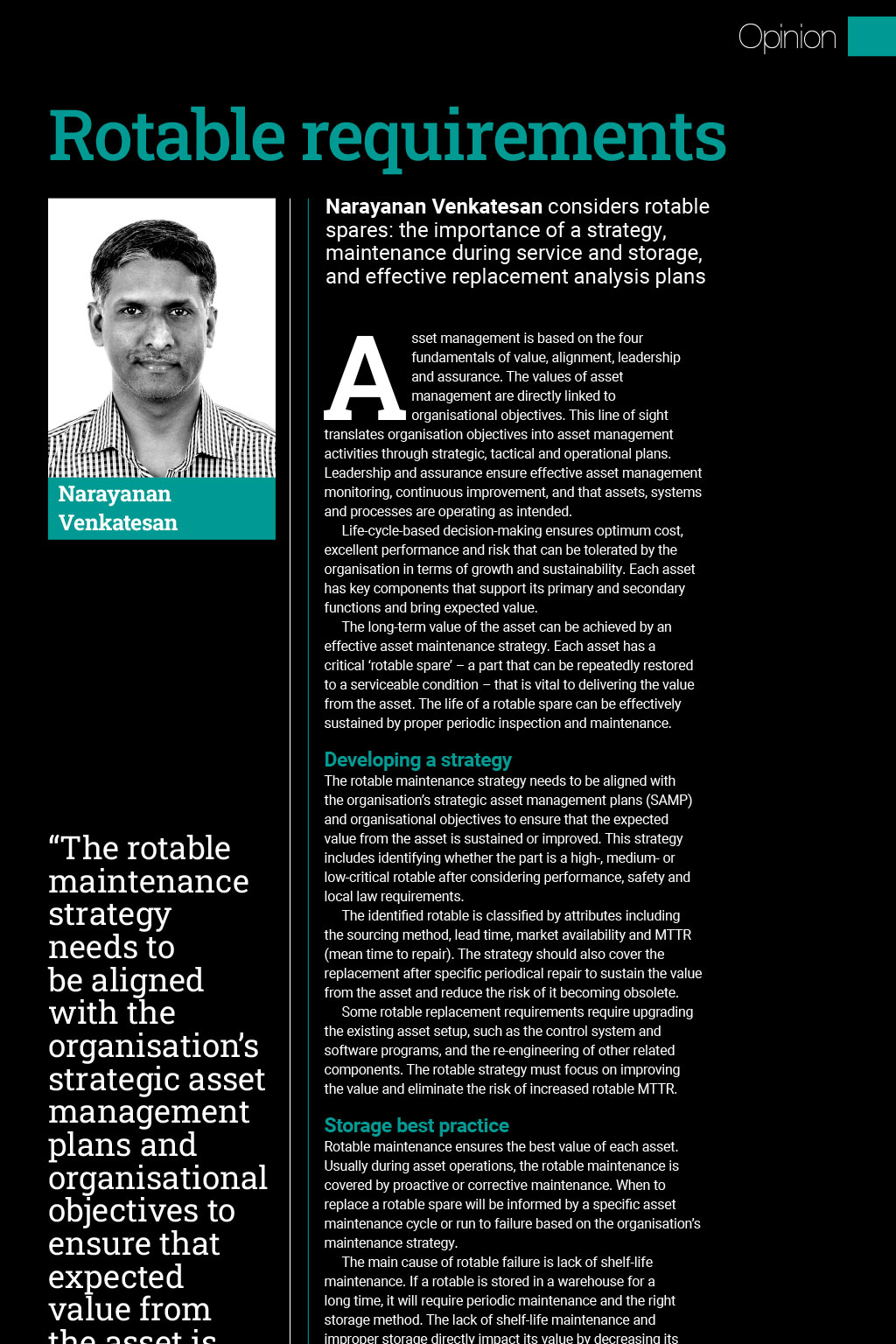




Opinion Rotable requirements Narayanan Venkatesan considers rotable spares: the importance of a strategy, maintenance during service and storage, and effective replacement analysis plans Narayanan Venkatesan Asset management is based on the four fundamentals of value, alignment, leadership and assurance. The values of asset management are directly linked to organisational objectives. This line of sight translates organisation objectives into asset management activities through strategic, tactical and operational plans. Leadership and assurance ensure effective asset management monitoring, continuous improvement, and that assets, systems and processes are operating as intended. Life-cycle-based decision-making ensures optimum cost, excellent performance and risk that can be tolerated by the organisation in terms of growth and sustainability. Each asset has key components that support its primary and secondary functions and bring expected value. The long-term value of the asset can be achieved by an effective asset maintenance strategy. Each asset has a critical rotable spare a part that can be repeatedly restored to a serviceable condition that is vital to delivering the value from the asset. The life of a rotable spare can be effectively sustained by proper periodic inspection and maintenance. Developing a strategy The rotable maintenance strategy needs to be aligned with the organisations strategic asset management plans and organisational objectives to ensure that expected value from the asset is sustained or improved The rotable maintenance strategy needs to be aligned with the organisations strategic asset management plans (SAMP) and organisational objectives to ensure that the expected value from the asset is sustained or improved. This strategy includes identifying whether the part is a high-, medium- or low-critical rotable after considering performance, safety and local law requirements. The identified rotable is classified by attributes including the sourcing method, lead time, market availability and MTTR (mean time to repair). The strategy should also cover the replacement after specific periodical repair to sustain the value from the asset and reduce the risk of it becoming obsolete. Some rotable replacement requirements require upgrading the existing asset setup, such as the control system and software programs, and the re-engineering of other related components. The rotable strategy must focus on improving the value and eliminate the risk of increased rotable MTTR. Storage best practice Rotable maintenance ensures the best value of each asset. Usually during asset operations, the rotable maintenance is covered by proactive or corrective maintenance. When to replace a rotable spare will be informed by a specific asset maintenance cycle or run to failure based on the organisations maintenance strategy. The main cause of rotable failure is lack of shelf-life maintenance. If a rotable is stored in a warehouse for a long time, it will require periodic maintenance and the right storage method. The lack of shelf-life maintenance and improper storage directly impact its value by decreasing its efficiency and causing premature failure. The shelf-life maintenance care for rotables should be linked to the SAMP for the best results. Replacement plans Often the rotable replacement plan for the asset is not given high priority because of associated expenses. The replacement plan involves data analysis on various aspects to bring better risk mitigation in case of rotable obsolescence and changes required in asset sub-systems where the rotable has a primary function in realising the value of the asset. The following points need to be considered: Narayanan Venkatesan is Asset Management Master Data and Refurbishment Lead in the heavy manufacturing industry. His 24-year career in asset management includes ERP maintenance, and his qualifications include PMP, PMI-PBA, IAM Diploma in Management, CMRP and CAMA 1.Effective tracking of rotable repair history (serialisation) 2. Identifying the life-cycle of the rotable and its performance 3.Upgrading requirements in feasibility analysis in case sub-systems have an impact on replacement 4.The number of times repaired and the subsequent effect on the rotables primary functions value 5.Effective disposal of identified rotable. To summarise, assets bring value to their organisations via the effective management of key components. The rotable spare plays a key role in the maintenance inventory and reliability of the primary function of the asset. Effective strategy and rotable management ensure better results by mitigating obsolescence risks and improving the time needed to repair the rotable.